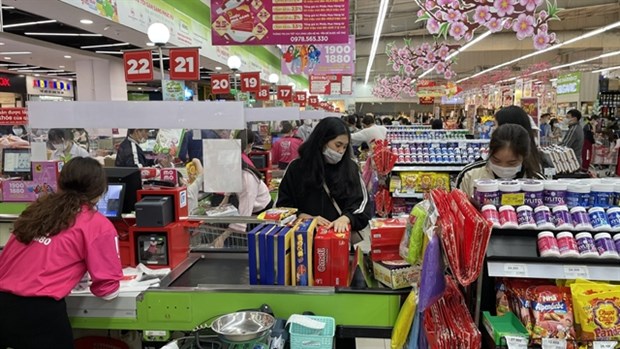
People shopping at a Big C supermarket. Businesses are facing many problems in implementing the new VAT rate. (Photo: VNA)
This policy is not new in Vietnam - the country did a similar move in 2009 to cushion the economy against the global financial crisis.
The rate cut this time will go through to December 31, 2022, and is applicable for the majority of goods and services, with exceptions in the fields of telecom services, financial services, securities, real estate, metals, chemicals and mining products, refinery and petrochemicals.
Essentially, all consumers and businesses are happy with the policy.
In theory, when an economy is in trouble, to stimulate consumption and relieve immediate pressure on people and help businesses survive, the government can take short-term tax policy actions involving tax breaks such as VAT and goods and services tax (GST). These indirect taxes apply as transactions take place, irrespective of whether a business is profitable. The effectiveness of this "prescription" has been proven by the fact that many other economies have taken similar steps in response to COVID-19, including Germany, Italy, the Republic of Korea, Spain, the UK and China.
In Vietnam, nearly a month after this policy was introduced, the implementation has not been smooth and effective.
Consumers can enjoy VAT reduction mostly in supermarkets, companies or big stores with clear invoices, while in traditional markets or streets shops, prices of many products have yet to decrease but even increase for a legitimate reason – increased petrol prices.
Nguyen Thi Binh, who shopped at Big C Thang Long in Hanoi, was happy to buy essential goods such as tissue paper, milk, noodles and household appliance at the new 8 percent VAT rate. The invoice clearly demonstrated which goods enjoy the new tax rate, and which are at the same rate. She saved 20,000 VND on a bill of about 1 million VND.
“The saving amount is not large but I’m happy to see the policy is brought into life and is benefiting consumers in this difficult time,” Binh said.
Supermarkets have more than 10,000 products in the group of fresh foods, technology products, fashion and apparel products, and some household appliances that have been eligible for a 2-per-cent VAT rate cut.
However, not all stores can apply new prices for customers. Many convenience stores add the value-added tax to product prices, so consumers are not clear on the benefits.
Hoang Minh Yen, a Hanoian, said she bought many goods including fruits and some essential items at a convenience store near her house in Minh Khai street for a total of 700,000 VND. The receipt only stipulates “price includes VAT”, so she does not know if she made any savings.
“When I asked, the salesman said he did not understand the implementation of a VAT reduction. The staff said he would forward the customer's complaint to the store manager and give feedback later,” Yen said.
Meanwhile, in traditional markets and street shops, most sellers do not issue invoices, and neither the seller nor the buyer knows and care about VAT. Buyers only care if the price of that item increases or decreases compared to before, while sellers said they sell goods based on cost and profit, not anything else.
“I only know how much I buy goods, plus profit, to calculate the selling price and don’t care how VAT increases or decreases. After Tet (Lunar New Year), prices of many goods increased due to higher input prices and gasoline prices,” said Nguyen Thi Hoa, a grocery saleswoman at a market in Hanoi.
As well as vegetables, other popular foods such as fresh vermicelli, pho (beef noodle) and bun ca (fish noodle) all saw prices increase.
Businesses confused
Recently, some tax departments in cities and provinces issued a document urging businesses to implement the VAT reduction policy. The tax authority also emphasised violations would be severely handled.
However, from the business side, they said they were facing many problems in implementing the new rule. Many complain they do not know clearly whether their sale items are on the list of goods and services eligible for a VAT cut or not.
In the process of tax declaration and tax imposition, many accountants are confused about reviewing and comparing goods and services of their businesses to the list of products and services eligible for a VAT cut. For example, can a photocopier business, when issuing invoices, get a 2 percent tax reduction when the input of ink is subject to a 10 percent VAT, but the paper is 8 percent? Or when selling alcohol, the VAT rate remains 10 percent, but if that bottle of beer is served to guests at a restaurant, it can enjoy the 8 percent rate.
This burden will be enlarged for enterprises selling thousands of items.
Besides, confusion remains for goods handed over and services completed, before the effective date of the policy, but have not yet been invoiced due to waiting for debt settlement or due to the Tet holiday or other objective reasons, will those goods and services enjoy tax cut?
According to Nguyen Van Thuc, chairman of BCTC Co Ltd, a tax service consulting company, many businesses and accountants are still confused about the new rule, as the policy took effect on February 1 during the Tet holiday and there was not enough time for firms to research and edit the accounting software.
In addition, using the code of goods and services to determine the subjects eligible for the 8-per-cent VAT rate is very broad. Businesses with hundreds or thousands of items, such as stationary businesses and supermarkets, need a lot of time and effort to check the items under the new rule.
Therefore, enterprises hope the Ministry of Finance will soon issue a detailed guidance circular.
Pham Thi Minh Hien, Deputy Director of Policy Department under the General Department of Taxation, said the tax authority had directed tax departments and branches in localities to further promote the information of the policy to people and businesses, as well as provide guidance, inspect and supervise the application of the new VAT rate.
"The policy is aimed to stimulate consumption demand," Hiền said, during the implementation process, tax authorities would check and supervise the selling prices of goods and services of businesses and would handle any violations./.
VNA
 Digital promotions reshape Vietnam’s e-commerce race
Digital promotions reshape Vietnam’s e-commerce race



